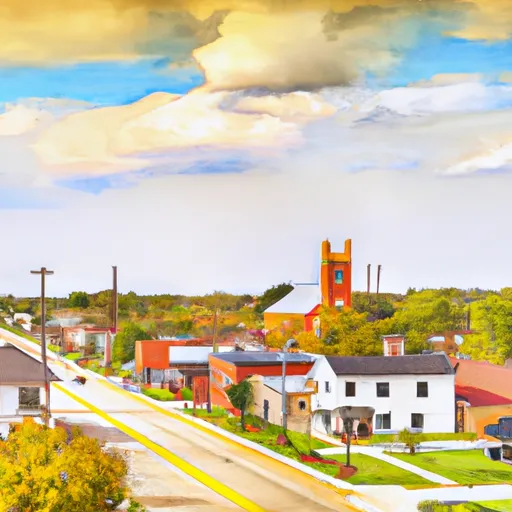-
 Snoflo Premium
Snoflo Premium
Get unlimited access to all our content
With no Ad interruptions! - Start Your Free Trial Login with existing account
Sweetser
Eden Index
Climate
7.9
•
Recreation
4.0
•
Community
1.0
•
Safeguard
4.8/10

Sweetser, Indiana is a small town located in Grant County in the Midwest region of the United States. The climate in Sweetser is classified as continental, with hot and humid summers and cold winters. Summers typically see temperatures reaching the mid-80s Fahrenheit (30 degrees Celsius), while winter temperatures often drop below freezing, with occasional snowfall.
The hydrology constituents in Sweetser are primarily influenced by nearby water bodies such as the Mississinewa River and Sweetser Lake. These bodies of water provide opportunities for fishing, boating, and other water sports. Additionally, the region's landscape is dotted with numerous ponds and creeks, adding to the natural beauty and recreational possibilities.
Outdoor enthusiasts will find several recreational opportunities in Sweetser. The town boasts a variety of parks and nature reserves, offering hiking trails, picnic areas, and wildlife observation. Sweetser also hosts events and festivals throughout the year, highlighting the area's natural attractions. Overall, Sweetser, Indiana provides a charming setting for outdoor lovers to immerse themselves in nature and enjoy a range of recreational activities.
What is the Eden Index?
The Snoflo Eden Index serves as a comprehensive rating system for regions, evaluating their desirability through a holistic assessment of climate health, outdoor recreation opportunities, and natural disaster risk, acknowledging the profound impact of these factors on livability and well-being.
Climate Health Indicator (CHI): 7.9
Sweetser receives approximately
1024mm of rain per year,
with humidity levels near 83%
and air temperatures averaging around
11°C.
Sweetser has a plant hardyness factor of
5, meaning
plants and agriculture in this region thrive during a short period during spring and early summer. Most
plants will die off during the colder winter months.
By considering the ideal temperature range, reliable water supplies, clean air, and stable seasonal rain or snowpacks, the Climate Health Indicator (CHI) underscores the significance of a healthy climate as the foundation for quality living.
A healthy climate is paramount for ensuring a high quality of life and livability in a region, fostering both physical well-being and environmental harmony. This can be characterized by ideal temperatures, reliable access to water supplies, clean air, and consistent seasonal rain or snowpacks.
Weather Forecast
Streamflow Conditions
Wabash
Area Rivers
Wabash
Snowpack Depths
Wabash
Reservoir Storage Capacity
Wabash
Groundwater Levels
Recreational Opportunity Index (ROI): 4.0
The Recreational Opportunity Index (ROI) recognizes the value of outdoor recreational options, such as parks, hiking trails, camping sites, and fishing spots, while acknowledging that climate plays a pivotal role in ensuring the comfort and consistency of these experiences.
Access to outdoor recreational opportunities, encompassing activities such as parks, hiking, camping, and fishing, is crucial for overall well-being, and the climate plays a pivotal role in enabling and enhancing these experiences, ensuring that individuals can engage in nature-based activities comfortably and consistently.
Camping Areas
| Campground | Campsites | Reservations | Toilets | Showers | Elevation |
|---|---|---|---|---|---|
| Deam Lake State Rec Area | 185 | 533 ft | |||
| Hardy Lake State Rec Area | 170 | 650 ft | |||
| Irwin City Park | 12 | 662 ft | |||
| Salt River Rec Area | None | 428 ft | |||
| Mississinewa Lake - Miami Recreation Area | 430 | 764 ft | |||
| White River Campground | 106 | 774 ft | |||
| Clark State Forest | 45 | 851 ft | |||
| Muscatatuck | 35 | 718 ft | |||
| Heflen Co Park | None | 639 ft | |||
| Charlestown State Park | 190 | 616 ft |
Nearby Ski Areas
Catastrophe Safeguard Index (CSI):
The Catastrophe Safeguard Index (CSI) recognizes that natural disaster risk, encompassing floods, fires, hurricanes, and tornadoes, can drastically affect safety and the overall appeal of an area.
The level of natural disaster risk in a region significantly affects safety and the overall livability, with climate change amplifying these risks by potentially increasing the frequency and intensity of events like floods, fires, hurricanes, and tornadoes, thereby posing substantial challenges to community resilience and well-being.
Community Resilience Indicator (CRI): 1.0
The Community Resilience Indicator (CRI) recognizes that education, healthcare, and socioeconomics are crucial to the well-being of a region. The CRI acknowledges the profound impact of these elements on residents' overall quality of life. By evaluating educational resources, healthcare accessibility, and economic inclusivity, the index captures the essential aspects that contribute to a thriving community, fostering resident satisfaction, equity, and social cohesion.

